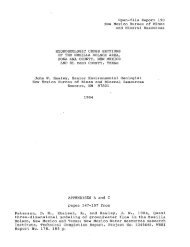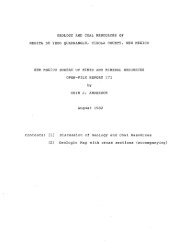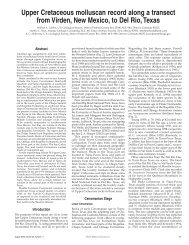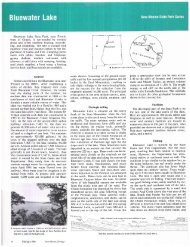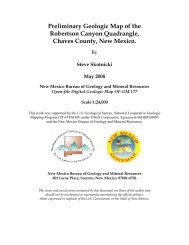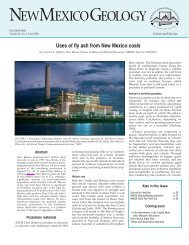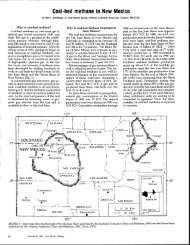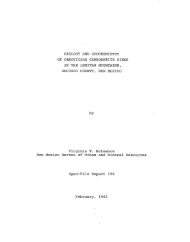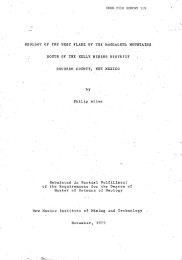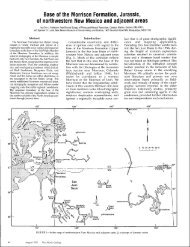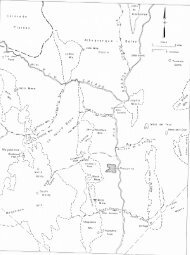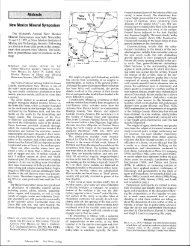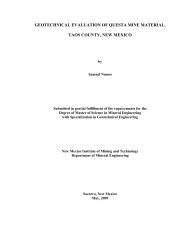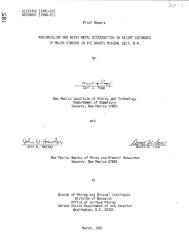Carbonatite dikes of the Chupadera Mountains, Socorro County
Carbonatite dikes of the Chupadera Mountains, Socorro County
Carbonatite dikes of the Chupadera Mountains, Socorro County
Create successful ePaper yourself
Turn your PDF publications into a flip-book with our unique Google optimized e-Paper software.
TABLE l-Ages <strong>of</strong> carbonatites and selected alkalic<br />
rocks in New Medco and Colorado. See Fig.<br />
I for approximate geographic locations.<br />
Garbonatite <strong>dikes</strong> <strong>of</strong> <strong>the</strong> <strong>Chupadera</strong> <strong>Mountains</strong>,<br />
<strong>Socorro</strong> Gounty, New Mexico<br />
by Bruce R. Van Allen and David L. Emmons, Tenneco Minerals Company, P.0. Box 27F, Lakewood, C0 80227 and<br />
Theodore P. Paster, Consulting Geologist, 11425 E. Cimmanon Dr., Englewood, C0 80111<br />
Introduction<br />
Calcitic carbonatites and thorium-bearing<br />
quartz deposits have been identified in <strong>the</strong><br />
sou<strong>the</strong>rn <strong>Chupadera</strong> <strong>Mountains</strong> in <strong>Socorro</strong><br />
Counfy. The <strong>dikes</strong> and quartz veins are hosted<br />
by Precambrian metamorphic rocks, whereas<br />
jasperoid occurs in Paleozoic carbonate rocks.<br />
The deposits occur in protracted sections 20,<br />
21, 28, and29, T5S, R1W on <strong>the</strong> nor<strong>the</strong>astern<br />
portion <strong>of</strong> <strong>the</strong> Pedro Armendaris Spanish<br />
Land Grant No. 34 and on <strong>the</strong> western edge<br />
<strong>of</strong> <strong>the</strong> Bosque del Apache National Wildlife<br />
Refuge. The approimate location <strong>of</strong> <strong>the</strong>se<br />
Bureau <strong>of</strong> Mines and Mineral Resources independently<br />
identified <strong>the</strong> carbonatites (Kent,<br />
1.982; Mclemore, 1983).<br />
Geologic setting<br />
The <strong>Chupadera</strong> <strong>Mountains</strong> are within a<br />
north-trending, west-tilted horst along <strong>the</strong><br />
western margin <strong>of</strong> <strong>the</strong> Rio Grande rift. <strong>Carbonatite</strong>s<br />
crop out in a 2 mi'exposure <strong>of</strong> Precambrian<br />
rocks (Fig. 2), which has been<br />
mapped and described by Kottlowski (1960),<br />
Condie and Budding (1979), Kent (1982),<br />
depths <strong>of</strong> t2-15 km, and metamorphosed at<br />
temperatures <strong>of</strong> 500-550"C. The exposed<br />
stratigraphic thickness <strong>of</strong> metasedimentary<br />
rocks may exceed 3,000 ft. Schistosity appr<strong>of</strong>mates<br />
original bedding and is indica.<br />
tive <strong>of</strong> two or more periods <strong>of</strong> folding before<br />
carbonatite emplacement. There aPPears to<br />
be at least one early west-northwest-trending<br />
episode <strong>of</strong> isoclinal folding followed by<br />
a'period <strong>of</strong> nor<strong>the</strong>ast-trending open folding<br />
(Bowring et al., 1983).<br />
Narrow bodies <strong>of</strong> biotite schist and amphibolite<br />
within <strong>the</strong> metasedimentary units<br />
deposits and <strong>the</strong> locations and ages <strong>of</strong> o<strong>the</strong>r Bowring et al. (1983), and now by <strong>the</strong> au- are probably metabasalt flows and intru-<br />
carbonatites in <strong>the</strong> region are shown in Fig.<br />
1 and Table 1.. The carbonatite <strong>dikes</strong> in <strong>the</strong><br />
<strong>Chupadera</strong>s were discovered during a contract<br />
uranium exploration program by United<br />
thors <strong>of</strong> this paper. The Precambrian host<br />
rocks are primarily interfingering quartz<strong>of</strong>eldspathic<br />
schist and gneiss, mica schist, and<br />
minor quartzite. These steeply dipping<br />
sives. Minor <strong>dikes</strong> <strong>of</strong> gneissic pegmatite and<br />
aplite are also present. Local porphyritic<br />
feldspathic schist may be metamorphosed<br />
felsic plutons and perhaps volcanic flows.<br />
Geophysical Colporation in 1954 (Reim, 1955). metamorphic rocks probably were inter- The youngest Precambrian metamorphic rock<br />
At that time <strong>the</strong> intrusives were described as<br />
"radioactive-calcite veins. " The "veins" were<br />
recognized as carbonatite <strong>dikes</strong> in 7978 by<br />
Tenneco geologists during a mineral reconnaissance<br />
program. In 1980, <strong>the</strong> New Mexico<br />
bedded argillaceous and arenaceous sediments<br />
with locally abundant felsic,<br />
volcaniclastic detritus. Condie and Budding<br />
(1979) suggested that <strong>the</strong> rocks were deposited<br />
during continental rifting, buried to<br />
is probably <strong>the</strong> foliated megacrystic granite<br />
in <strong>the</strong> sou<strong>the</strong>rn portion <strong>of</strong> <strong>the</strong> Precambrian<br />
exposure. Based on zircon U-Pb isotopic data,<br />
this metamorphosed granite is 1,659 -+ 3 m.y.<br />
old (Bowring et al., 1983). <strong>Carbonatite</strong> is <strong>the</strong><br />
Locality<br />
1. <strong>Chupadera</strong> <strong>Mountains</strong><br />
carbonatite<br />
2. Lemitar <strong>Mountains</strong><br />
carbonatite<br />
3. Monte Largo Hills<br />
carbonatite<br />
4. Lobo Hill<br />
syenite and<br />
carbonatite<br />
5. Pedernal Hills<br />
syenite<br />
5. Caballo <strong>Mountains</strong><br />
syenite<br />
7. Florida <strong>Mountains</strong><br />
quartz syenite<br />
8, Powderhorn dishict<br />
carbonatites and<br />
associated alkalic<br />
rock<br />
9. Wet <strong>Mountains</strong><br />
district<br />
carbonatites and<br />
associated alka.lic<br />
rock<br />
Ate<br />
(m.y.) Reference<br />
? This paper<br />
M9 Mclemore, 1982<br />
? Loring and<br />
Armstrong, 1980<br />
youngest pre-Tertiary intrusive rock and is<br />
<strong>Carbonatite</strong>s<br />
not metamorphosed.<br />
The carbonatites occur as a nor<strong>the</strong>asterly<br />
A thin wedge <strong>of</strong> Paleozoic limestone and trending, arcuate swarm <strong>of</strong> steeply dippin!<br />
arkose unconformably overlies <strong>the</strong> sou<strong>the</strong>rn <strong>dikes</strong> that cut <strong>the</strong> foliation <strong>of</strong> <strong>the</strong> Precam-<br />
margin <strong>of</strong> <strong>the</strong> Precambrian rocks. These sedbrian rocks. The <strong>dikes</strong> typically are exposed<br />
imentary rocks contain no carbonatite <strong>dikes</strong> within a thin, laterally extensive colluvium<br />
and are presumed to be younger. Poor ex- as rows <strong>of</strong> boulders. Wall-rock contacts are<br />
posures and major jasperoid zones make rarely observed (Fig. 3). The intrusives are<br />
identification <strong>of</strong> <strong>the</strong> Paleozoic formations un- in long, narrow zones which, in some excertain.<br />
However, Kottlowski (1950) and Egposures, contain up to three closely spaced,<br />
gleston (1982) have documented <strong>the</strong> CaloJo adjacent <strong>dikes</strong>. Individual <strong>dikes</strong> commonly<br />
(Mississippian) and Sandia (Pennsylvanian) ar6 0.2-q.9 ft thick. Select <strong>dikes</strong> have been<br />
Formations in <strong>the</strong> map area.<br />
traced continuously in outcrop for up to 200<br />
To <strong>the</strong> north and east <strong>the</strong> Precambrian rocks ft along strike. Four dike zones exceed 1,000<br />
are covered by a thick Cenozoic section <strong>of</strong> ft in shike length and may exceed 5,000 ft<br />
ash-flow tuff, felsic volcanic flows, basalt, and with only minor lateral <strong>of</strong>fset by faults. The<br />
sedimentary rocks, which compose most <strong>of</strong> extent <strong>of</strong> carbonatites concealed by Paleozoic<br />
<strong>the</strong> <strong>Chupadera</strong> <strong>Mountains</strong> (Eggleston, 1982). and younger rocks is unknown.<br />
To <strong>the</strong> west <strong>the</strong> Precambrian rocks are down- <strong>Carbonatite</strong> textures range from fine to<br />
thrown by <strong>the</strong> <strong>Chupadera</strong> fault.<br />
coarse grained and from equigranular to por-<br />
ExPlo<br />
I<br />
Alluvium I<br />
cenozoic 5onlo Fe .9<br />
broup ,:<br />
terlrory votcontc ;<br />
Josperoid<br />
Poleozoic Iimestone I L<br />
Corbonolite <strong>dikes</strong><br />
Scole<br />
o 05<br />
o I,OOO 2,OOO f t<br />
FlgUlE 2-Gene:alized geologicmap_<strong>of</strong> carbonatites in <strong>the</strong> <strong>Chupadera</strong> <strong>Mountains</strong> (precambrian rocks<br />
atter Kent, 1982; Tertiary rocks after Eggleston, I98Z; and mapping by <strong>the</strong> authors <strong>of</strong> this paper).<br />
May 1986 Nm Mexico Geology<br />
f<br />
Gronile<br />
Porphyritic schist<br />
Amphibolite ond schist<br />
Ouorlzo{eldspothic<br />
schisl ond gneiss<br />
lVico schist<br />
\<br />
o<br />
"on,o.,<br />
: side; dotted<br />
if buried<br />
strike ond dip<br />
foliotion<br />
phyritic. Many <strong>of</strong> <strong>the</strong> intrusives are microbreccias,<br />
with rounded and irregular<br />
carbonatite fragments set in a carbonatite<br />
matrix with similar composition. Phenocrysts,<br />
carbonatite fragments, and wall-rock<br />
inclusions generally align to form flow banding<br />
and local flowage segregation. Many <strong>dikes</strong><br />
are uniform in texfure, but some have variable<br />
texture along strike. Wider portions <strong>of</strong><br />
o<strong>the</strong>rs possibly are composite intrusives with<br />
sharp contacts between different phases that<br />
are distinguished by textural contrast.<br />
The carbonatites are moderate brown on<br />
fresh surfaces and yellowish brown to reddish<br />
brown where wea<strong>the</strong>red. Xenoliths and<br />
phenocrysts <strong>of</strong> magnetite, apatite, and bio-<br />
FIGURE 3-Outcrop <strong>of</strong> a 2.4-ft-thick carbonatite<br />
dike. Wall-rock coniacts are concealed by colluvlum.<br />
New AAex[c@<br />
GEOLOGY<br />
. Soience and Seruice<br />
Volume 8, No. 2, May 1946<br />
Editor: Deborah A Shaw<br />
Published quarterly by<br />
New Mexico Bureau <strong>of</strong> Mines and Mineral Resources<br />
a division <strong>of</strong> New Mqio lnstitute <strong>of</strong> Mining & Tchrology<br />
BOARD OF REGENTS<br />
Ex Officio<br />
Toney Anaya, Gooernor <strong>of</strong> Nru Mexico<br />
Alan Morgan, Superintendent ol Public lnstruclion<br />
ADDointed<br />
Steve Torres, PieZ , t967-1997, <strong>Socorro</strong><br />
Judy Floyd, Sec lTreas , 1977-7987, Ins Cruces<br />
Cilbert L Cano, 1985-1997, Albuquerque<br />
Lenton Malry, 1985-1989, Albuquerque<br />
Donald W Morris, 1983-1989, Ips Alamos<br />
New Mexico Institute <strong>of</strong> Mining & Technology<br />
Ptridffit Laurence H Lattman<br />
New Mexico Bureau <strong>of</strong> Mines & Mineral Resources<br />
Director Frank E Kottlowski<br />
Acting Deputy Director James M Robertson<br />
Subscriptions: Issued quarterly, February, May, August,<br />
November; subsqiption price $6 O0/calendar year<br />
Edttotiol mattq: Articles submitted for oublication should<br />
be in <strong>the</strong> editor's hands a minimum <strong>of</strong> five 15) months<br />
before date <strong>of</strong> publication (February, May, August, o!<br />
Novenber) and should be no longer than 20 typewritten,<br />
double-spaced pages. All scientific pape$ will be<br />
reviewed by at least two people in <strong>the</strong> appropriate field<br />
<strong>of</strong> study Address inquiries to Deborah A Shaw, Editor<br />
ot Nru Mexico Geology, New Mexico Bureau <strong>of</strong> Mines &<br />
Mineral Resources, <strong>Socorro</strong>, NM 87801<br />
Published. as public domain, <strong>the</strong>relore reproducible without per<br />
fr5sion. Source credit rcquested<br />
Circuletion: 1 ,600<br />
Prinler University <strong>of</strong> New Mexico Printing Plant
tite characteristically stand in positive relief feldspar commonly b<br />
from wea<strong>the</strong>red carbonate matrix. Angular morphology and occa<br />
wall-rock xenoliths in <strong>the</strong> <strong>dikes</strong> are up to 0.7 polysyn<strong>the</strong>tic plagiocle<br />
ft long and commonly have reddish rims be- apparent from oriented<br />
cause <strong>of</strong> hemat2ation. clear carbonate aggrei<br />
Minerarogy ;ffit,4'**".106'"<br />
The carbonatites are composed <strong>of</strong> calcite eral^. Some samples contain partly nium oxides.<br />
with trace to moderate amounts <strong>of</strong> o<strong>the</strong>r recrystallized, fine-grained carbonate mo-<br />
minerals commonly found in carbonatites saicJ, making clouiy and originally clear<br />
(Table 2). A semiquantitative x-ray diffraction grains indistiiguisha'ble.<br />
Geochemistry<br />
Geochemistry, like mineralogy, is highly<br />
analysis <strong>of</strong> sample 45h indicates 55-657a cal- <strong>Carbonatite</strong> breccia<br />
clte, 12-15Vo dolomite, 8-10% apatite, 5-10Vo granular, anhedral, cle<br />
kaolinite(?), 3-5Vo quartz, and trace chlorite. altered biotite, magne<br />
Some carbonatite slabs reveal a swelling clay, con. These minerals ;<br />
perhaps montmorillonite, as possible pseu- phenocrysts. Most cart<br />
domorphs after feldspar phenocrysts or in- phenocrysts are rour<br />
clusions. cause <strong>of</strong>abrasion and 1<br />
Two primary carbonate textures are rec- tite commonly contains<br />
ognized in thin section (Figs. 4 and 5). occasionally-is completely replaced by la-<br />
G-roundmass carbonate (
ichment <strong>of</strong> uranium, thorium, yttrium, and<br />
rare-earth elements, which is diagnostic <strong>of</strong><br />
carbonatites (Table 4). A gamma-ray spectrometer<br />
survey has established that radioactivity<br />
is extremely variable along dike<br />
outcrops and that uranium and thorium generally<br />
are unassociated. Dikes in southwestern<br />
outcrops commonly have <strong>the</strong> greatest<br />
concentrations <strong>of</strong> most trace elements.<br />
Linear correlation coefficients (r) better define<br />
<strong>the</strong> interassociation <strong>of</strong> minor elements<br />
(Table 5). Based on student t tests, r values<br />
with a variance <strong>of</strong> 0.34 from zero are indicative<br />
<strong>of</strong> significant positive or negative correlation<br />
with greater than 95% confidence for<br />
all element pairs except for those containing<br />
TABLE 3-Whole-rock geochemistry in percent. Assays were done by commercial laboratories. + Standard<br />
whole-rock geochemistry. $ After Gold, 1966. f Quantitative x-ray fluorescence. +* Total iron<br />
"rp."rt"d "t F"rO"<br />
Oxide<br />
sio,<br />
CO,<br />
Tio,<br />
Al203<br />
Fe2O3*'<br />
MnO<br />
Mgo<br />
CaO<br />
Na2O<br />
KO<br />
PrOt<br />
Samples from <strong>the</strong> <strong>Chupadera</strong> <strong>Mountains</strong><br />
45h* 45h' 47b'<br />
I0.27o<br />
JI. I<br />
0.91<br />
1.31<br />
4.64<br />
0.89<br />
3.42<br />
43.3<br />
0.046<br />
0.070<br />
3.51<br />
7.77o<br />
1.11<br />
1.9<br />
5.48<br />
0.82<br />
3.70<br />
43.49<br />
TABLE S-Linear correlation coefficients (r values) <strong>of</strong> selected minor and heavy elements, listed in order <strong>of</strong> abundance. These were based on-up to<br />
43 element pairs calculated from analysei summarized in Table 4. Element puirs wet" discarded when <strong>the</strong>re was a value below detection limits'<br />
Elements with no detections were Ba (4), Ce+La (4), Th (16), and Rb (14).<br />
El"-"nt F" Mn Ti B" F C" + L" Z. St Nb Y Th ztt Ni Rb u Pb crt<br />
Cu<br />
Pb<br />
IT<br />
Rb<br />
Ni<br />
Zn<br />
Th<br />
Y<br />
Nb<br />
Sr<br />
Zr<br />
Ce -f La<br />
F<br />
Ba<br />
Ti<br />
Mn<br />
Fe<br />
0.42 0.17 0.53 -0.25 0.23 0.01<br />
0.09 - 0.31 - 0.03 0.30 0.02 0.52<br />
- 0.50 0.03 - 0.47 0.25 - 0.04 0.10<br />
-0.06 0.28 -0.03 0.16 -0.28 0.36<br />
0.58 0.36 0.50 -0.07 0.25 0.43<br />
0.41 -0.29 0.37 0.07 -0.03 0.33<br />
-0.31 0.32 -0.33 0.04 -0.25 0.39<br />
-0.42 0.23 -0.42 - 0.01 -0-02 0.26<br />
0.10 0.10 - 0.03 0.02 0.37 0.47<br />
0.42 -0.11 0.32 0.20 0.27 0.45<br />
0.48 0.40 0.47 0.04 0.40 0.75<br />
0.31 0.25 0.06 0.10 0.38 1.00<br />
0.35 0.29 0.26 -0.02 1.00<br />
-0.15 0.03 -0.27 1.00<br />
0.79 0.04 1.00<br />
0.17 1.00<br />
1.00<br />
disseminated hematite may be related to<br />
widespread mild fenitization, but more likely<br />
it formed during deuteric or metamorphic<br />
processes before carbonatite magmatic activity.<br />
Carbonate replacements and minor veinlets<br />
<strong>of</strong> secondary calcite within <strong>the</strong> carbonatites<br />
represent minor recrystallization after<br />
dike emplacement. The recrystallization appears<br />
to have been predominantly isochemical.<br />
Subsequent partial wea<strong>the</strong>ring altered<br />
select orthoclase and chlorite to clay and altered<br />
minor amounts <strong>of</strong> titaniferous magnetite<br />
to hematite, goethite, and leucoxene.<br />
Some porphyritic <strong>dikes</strong> may be texturally<br />
similar to select carbonate rocks in <strong>the</strong> Wet<br />
<strong>Mountains</strong> <strong>of</strong> Colorado (Armbrustmacher,<br />
pers. comm. 1985), which are interpreted to<br />
be replacements <strong>of</strong> lamprophyre <strong>dikes</strong>. These<br />
rocks are named "replacement carbonatites"<br />
bv Armbrustmacher 0,979\. However, it is<br />
irirprobable that <strong>the</strong> carbonatites <strong>of</strong> <strong>the</strong> <strong>Chupadera</strong><br />
<strong>Mountains</strong> formed in this manner.<br />
More likely <strong>the</strong> petrogt'aphy reflects variable<br />
instabilitv <strong>of</strong> phenocrvsts and inclusions<br />
during niug-uti. emplicement. All phenocrysts,<br />
carbonatite fragments, and, to a minimal<br />
extent, wall-rock inclusions display<br />
partial resorption by carbonate, and most<br />
phenocryst minerals are chemically altered.<br />
Thorium-bearing jasperoid<br />
and quartz veins<br />
The Caloso Formation (Mississippian)<br />
contains jasperoid that can be traced in continuous<br />
outcrop for up to 0.5 mi along strike.<br />
The jasperoid extensively replaced <strong>the</strong> formation<br />
near <strong>the</strong> Paleozoic-Precambrian unconformity.<br />
Basal mineralization is dark<br />
reddish brown (because <strong>of</strong> disseminated<br />
hematite), fine grained, and commonly radioactive<br />
(because <strong>of</strong> thorium). Portions <strong>of</strong><br />
<strong>the</strong> jasperoid contain minor calcite, iron- and<br />
manganese-oxide joint coatings, and concentrations<br />
<strong>of</strong> barite. The silicification has<br />
enclosed fine detrital grains <strong>of</strong> quartz, feldspar<br />
(which is partly corroded), and trace<br />
muscovite. Carbonate inclusions are abundant<br />
where jasperoid grades into unreplaced<br />
0.38 0.11 - 0.04 - 0.36 - 0.19<br />
0.34 0.58 0.22 -0.20 -0.15<br />
-0.14 -0.01 0.03 0.70 0.39<br />
0.35 - 0.03 0.L7 0.14 0.36<br />
0.45 0.24 0.28 0.25 0.10<br />
0.28 0.30 0.05 -0.51 -0.27<br />
0.20 -0.77 0.06 0.26 0.05<br />
0.09 0.56 1.00<br />
- 0.05 - 0.26 0.27 1.00<br />
0.37 0.25 1.00<br />
0.55 1.00<br />
1.00<br />
-0.32 -0.19 1.00<br />
0.68 -0.24 -0.08 0.14 1.00<br />
-0.28 0.72 -0.21 1.00<br />
0.07 0.11 1.00<br />
- 0.15 1.00<br />
1.00<br />
host rock. Semiquantitative x-ray fluorescence<br />
(XRF) analyses <strong>of</strong> seven jasperoid samples<br />
reveal maximum concentrations in<br />
individual samples <strong>of</strong> 3l% Ba,2Vo Fe, 0.257o<br />
Zr,0.74Vo Mn, 560 ppm Th, 560 ppm Cu, 360<br />
ppm Y and 56 ppm U. Rare-earth elements<br />
were not detected.<br />
Three radioactive, hematitic, quartz veins<br />
were found in Precambrian rocks. One similar<br />
vein occurs within a carbonatite dike.<br />
The veins are less than 1 ft in maimum width<br />
and are <strong>of</strong> short strike length. Semiquantitative<br />
XRF analyses <strong>of</strong> three vein samples<br />
contain up to 3.97o Fe, 0.46% Zr, 400 PPm Y<br />
340 ppm U, and 270 ppm Th. The veins contain<br />
no barite or detectable rare-earth elements.<br />
The hematitic jasperoid and quartz veins<br />
are <strong>of</strong> uncertain origin. Somewhat similar<br />
hematitic ouartz-microcline-barite-carbonate<br />
veins with thorium, yttrium, and rareearth<br />
elements occur in o<strong>the</strong>r carbonatite districts<br />
such as <strong>the</strong> Wet <strong>Mountains</strong> and Powderhorn<br />
areas <strong>of</strong> Colorado and <strong>the</strong> Lemhi<br />
Pass area <strong>of</strong> Idaho and Montana (Phair and<br />
Fisher, 1961).<br />
Age and regional significance<br />
<strong>Carbonatite</strong>s <strong>of</strong> <strong>the</strong> <strong>Chupadera</strong> <strong>Mountains</strong><br />
have a mineralogical, geochemical, and geological<br />
setting comparable to <strong>the</strong> late Ordovician<br />
carbonatites in <strong>the</strong> Lemitar <strong>Mountains</strong><br />
(Mclemore, 1983). These carbonatites lie in<br />
a regional belt <strong>of</strong> Late Precambrian to Late<br />
Silurian carbonatites and alkalic rocks, which<br />
extends from sou<strong>the</strong>rn New Mexico to central<br />
Colorado (Fig. 1). The intrusives probably<br />
formed during a period <strong>of</strong> extensionwithin<br />
a zone that approximates <strong>the</strong> Cenozoic Rio<br />
Grande rift and possibly a Precambrian rift<br />
system.<br />
Thorium-bearing quartz occurs spatially,<br />
but probably not temporally, related to carbonatites<br />
<strong>of</strong> <strong>the</strong> <strong>Chupadera</strong> <strong>Mountains</strong>. The<br />
Mississippian or younger thorium-rich jasperoid<br />
appears younger in age than <strong>the</strong> carbonatites.<br />
Additional research on <strong>the</strong> genesis<br />
<strong>of</strong> <strong>the</strong> thorium occurrences is warranted.<br />
ACKNowLEDGlrrNrs-This manuscript was<br />
critically reviewed by Theodore J. Armbrustmacher<br />
and Virginia T. Mclemore. Frederick<br />
B. Park, Neil K. Muncaster, and Jeffrey L.<br />
Wilson also provided valuable comments.<br />
References<br />
Armbrustmacher, T. l. 1979, Replacement and primary<br />
magmatic carbonatites from <strong>the</strong> Wet <strong>Mountains</strong> area,<br />
Freiront and Custer Counties, Colorado: Economic<br />
Geology, v. 74, pp. 888-901<br />
Arnbrustmacher, T. J., and Brownfield, l. K., 1978, <strong>Carbonatite</strong>s<br />
in <strong>the</strong> Wet <strong>Mountains</strong> area, Custer and Fremont<br />
Counties, Colorado-chemical and mineralogical<br />
data: U.S. Geological Survey, Open-file report 78-1.77,<br />
b PP.<br />
Armbrustmacher, T. J., and Hedge, C. E., 1982, Genetic<br />
implications <strong>of</strong> minor-element and Sr-isotoPe 8eochemistry<br />
<strong>of</strong> alkaline rock complexes in <strong>the</strong> Wet <strong>Mountains</strong><br />
area, Fremont and Custer Counties, Colorado:<br />
Contributions to Mineralogy and Pehology, v.79, pp.<br />
424-435.<br />
Beny, L. G., and Mason, B., 1959, Mineralogy-concePts,<br />
descriotions, determinations: W. H. Freeman and<br />
Compiny, San Francisco, 630 pp.<br />
Bowring, S. A., Kent, S. C., and Sumner, W., 1983, Geology<br />
and U-Pb geochronology <strong>of</strong> Proterozoic rocks in<br />
<strong>the</strong> vicinity <strong>of</strong> <strong>Socorro</strong>, New Mexico: New Mexico Geological<br />
Society, Guidebook to 34th Field Conference,<br />
pp. 1.37-142.<br />
Brookins, D. C., 1974, Radiometric age determinations<br />
from <strong>the</strong> Florida <strong>Mountains</strong>, New Mexico: Geology, v<br />
2, pp.555-557.<br />
Condie, K. C., and Budding, A. 1., 7979, Geology and<br />
geochemistry <strong>of</strong> Precambrian rocks, central and southcentral<br />
New Mexico: New Mexico Bureau <strong>of</strong> Mines and<br />
Mineral Resources, Memoir 35, 60 pp.<br />
Eggleston, T. L., 1982, Geology <strong>of</strong> <strong>the</strong> central <strong>Chupadera</strong><br />
<strong>Mountains</strong>, Socono <strong>County</strong>, New Mexico: Unpublished<br />
M.S. Thesis, New Mexico Institute <strong>of</strong> Mining<br />
and Technology, Socono, 162 pp.<br />
Gold, D. P., 1965, The average and typical chenical composition<br />
<strong>of</strong> carbonatites; ln Intemational rnineralogical<br />
association volume: Mineralogical Society <strong>of</strong> India, pp.<br />
83-91.<br />
Kapustin, Y- L., 1,980, Mineralogy <strong>of</strong> carbonatites (English<br />
hanslation): Amerind Publishing Company Pvt. Ltd.,<br />
New Delhi, India,259 pp.<br />
Kent, S., 1982, Geologic maps <strong>of</strong> Precambrian rocks in<br />
<strong>the</strong> Magdalena and <strong>Chupadera</strong> <strong>Mountains</strong>, Socono<br />
<strong>County</strong>, New Mexico: New Mexico Bureau <strong>of</strong> Mines<br />
and Mineral Resources, Open-file Report 170, 2 maps,<br />
scale 1:12,000.<br />
Kottlowski, F. E., 1960, Summary <strong>of</strong> Pennsylvanian sections<br />
in southwestern New Mexico and sou<strong>the</strong>astern<br />
Arizona: New Mexico Buteau <strong>of</strong> Mines and Mineral<br />
Resources, Bulletin 66, 187 pp.<br />
Le Bas, M. l. 1977, <strong>Carbonatite</strong>-nephelinite volcanism,<br />
an African case history: John Wiley and Sons, New<br />
York,347 pp.<br />
continued on page 40<br />
New Mexico Ceotogy May 1986
cordingly. Generally, only <strong>the</strong> very best gas<br />
prospects, or those gas prospects required to<br />
hold leases, were drilled in 1985. However,<br />
existing gas pools in <strong>the</strong> San |uan Basin continued<br />
to be developed.<br />
ACKNowLEDGwNTs-Prentiss Childs <strong>of</strong> <strong>the</strong><br />
New Mexico Oil Conservation Division provided<br />
<strong>the</strong> well completion statistics. Richard<br />
Stamets <strong>of</strong> <strong>the</strong> New Mexico Oil Conservation<br />
Division provided data on <strong>the</strong> volume <strong>of</strong> oil<br />
and gas produced. David Donaldson <strong>of</strong> <strong>the</strong><br />
New Mexico Bureau <strong>of</strong> Geology provided <strong>the</strong><br />
reserve statistics. Robert Bieberman, Frank<br />
Kottlowski, and Sam Thompson, III, reviewed<br />
<strong>the</strong> manuscript. Lynne McNeil typed<br />
<strong>the</strong> manuscript and Cherie Pelletier drafted<br />
<strong>the</strong> illustration.<br />
References<br />
lup Sandstone (Upper Cretaceous) <strong>of</strong> northwestem New<br />
Mexico: New Mexico Bureau <strong>of</strong> Mines and Mineral Resources,<br />
Circular 764, 32 pp<br />
Ca<strong>the</strong>r, S. M., and Johnson , B. D., 1,984, Eocene tectonics<br />
and depositional setting <strong>of</strong> west-central New Mexico<br />
and eastem Arizona: New Mexico Bureau <strong>of</strong> Mines and<br />
Mineral Resources, Circular 192,33 pp<br />
Energy Information Administration, 1985, U.S crude oil,<br />
natural gas, and natural gas liquids reserues: U S. Department<br />
<strong>of</strong> Energy, Energy lnforrnation Administration,<br />
1984 annual report, DOE/EIA-0216(84), 98 pp<br />
Foster, R W, 1980, Carbon dioxide sources and use for<br />
enhanced oil recovery: New Mexico Petroleum Recovery<br />
Research Center, Report 80-4, 73 pp<br />
Kelley, V C , 7978, Geology <strong>of</strong> Espafrola Basin, New Mexico:<br />
New Mexico Bureau <strong>of</strong> Mines and Mineral Resources,<br />
Geologic Map 48, scale 1:125,000<br />
Kinney, E E (ed),7967, The oil and gas fields <strong>of</strong> sou<strong>the</strong>astern<br />
New Mexico: Roswell Geological Society,'1.967<br />
Symposium Supplement, 195 pp.<br />
Kottlowski, F. E , and Stewart, W J., 1970, The Wolfcampian<br />
Joyita uplift in cenhal New Mexico: New Mexico<br />
Bureau <strong>of</strong> Mines and Mineral Resources, Memoir<br />
23,pt I, pp 1-31<br />
Oil and Gas Journal, 1985, Selected U.S. and world cmde<br />
prices: Oil and Gas Journal, v. 83, no. 1, p. 120.<br />
Oil and Gas Journ al, 1986a, Selected U S. and world crude<br />
prices: Oil and Gas Journal, v. 84, no 2, p. 85.<br />
Oil and Gas foumal, 1985b, AGA-gas surplus to retain<br />
price rein: Oil and Gas Journal, v. 84, no. 1, pp 52-53<br />
Stamets, R L , Kautz, P, Brooks, L , and Busch, E , 1985,<br />
New Mexico: The Oil and Gas Compact Bulletin, v. tl4,<br />
no 1, pp 31-33<br />
Stone, W J , Lyford, F. P, Frenzel, P F., Mizell, N H ,<br />
and Padgett, E. T.,1983, Hydrogeology and water resources<br />
<strong>of</strong> San Juan Basin, New Mexico: New Mexico<br />
Bureau <strong>of</strong> Mines and Mineral Resources, Hydrologic<br />
Report 6, 70 pp<br />
Thompson, S, III, 1980, Pedregosa Basin's main exploration<br />
target is Pennsylvanian dolostone: Oil and Gas<br />
Journal, v 78, no. 42, pp 202, 207, 21.0, 215.<br />
Thompson, S, III, 1981, Petroleum source rocks in exploration<br />
wells drilled to Paleozoic or Mesozoic units,<br />
Hidalgo and Grant Counties, New Mexico: New Mexico<br />
Energy Institute, Report EMD 2-55-3306,720 pp<br />
Thompson, S, ilI, and Jacka, A. D, 7981, Pennsylvanian<br />
shatigraph, pehography, and petroleum geology <strong>of</strong><br />
<strong>the</strong> Big Hatchet Peak section, Hidalgo <strong>County</strong>, New<br />
American Gas Association, 1984, The gas energy demand Meyer, R F, 1955, Geology <strong>of</strong> Pennsylvanian and Wolf- Mexico: New Mexico Bureau <strong>of</strong> Mines and Mineral Re-<br />
outlook: 1984-2000: American Gas Association, Arlingcampian rocks in sou<strong>the</strong>ast New Mexico: New Mexico sources, Circular 1.76, 1.25 pp.<br />
ton, Virginia, 90 pp<br />
Bureau <strong>of</strong> Mines and Mineral Resources. Memoir 17, Woodward, L A, Callender,J F., Seager,W R, Chapin,<br />
Broadhead, R F, and King, W. E, 1985, Preliminary<br />
report on <strong>the</strong> stratigraphy and structure <strong>of</strong> Pennsylvanian<br />
and lower Permim strata, Tucumcari Basin: New<br />
Mexico Geological Society, Guidebook to 36th Field<br />
123 pp<br />
Molenaar, C M ,9n, Stratigraphy and depositional history<br />
<strong>of</strong> Upper Cretaceous rocks <strong>of</strong> <strong>the</strong> San Juan Basin<br />
area, with a note on economic resources: New Mexico<br />
C E , Gries, J C, Shaffer, W L, and Zilinski, R E ,<br />
1978, Tectonic map <strong>of</strong> Rio Grande rift region in New<br />
Mexico, Chihuahua, and Texas; inHawley, J W (compiler),<br />
Guidebook to Rio Grande rift in New Mexico<br />
Conference, pp 151-155<br />
Geological Society, Guidebook to 28th Field Confer- ind Colorado: New Mexico Bureau <strong>of</strong> Mines and Min-<br />
Campbell, C.V.,1979, Model for beach shoreline in Galence, pp 159-166<br />
eral Resources, Circular 153, sheet 2 tr<br />
continued from page 29<br />
Loring, A K, and Armstrong, D G , 1980, Cambrian-<br />
Ordovician syenites <strong>of</strong> New Mexico, part <strong>of</strong> a regional<br />
alkalic intrusive episode: Geology, v 8, pp 3114-348<br />
Mclemore, V. T , 7982, Geology and geochemistry <strong>of</strong> Ordovician<br />
carbonatite <strong>dikes</strong> in <strong>the</strong> Lemitar <strong>Mountains</strong>,<br />
<strong>Socorro</strong> <strong>County</strong>, New Mexico: New Mexico Bureau <strong>of</strong><br />
Mines and Mineral Resources, Open-file Report 158,<br />
r12 pp<br />
Mclemore, V T, 1983, <strong>Carbonatite</strong>s in <strong>the</strong> Lemitar and<br />
<strong>Chupadera</strong> <strong>Mountains</strong>, Socono <strong>County</strong>, New Mexico:<br />
New Meico Geological Society, Guidebook to 34th Field<br />
Conference, pp 235-240<br />
Mclemore, Y. T , 1984, Preliminary report on <strong>the</strong> geology<br />
md mineral-resource potential <strong>of</strong> Tonance <strong>County</strong>, New<br />
Mexico: New Mexico Bureau <strong>of</strong> Mines and Mineral Resources,<br />
Open-file Report 192,277 pp<br />
Olson, J C, Marrrn, R F, Parker, R L, and Mehnert,<br />
H. H , 1977, Age and tectonic setting <strong>of</strong> lower Paleozoic<br />
alkalic and mafic rocks, carbonatites, and thorium veins<br />
in south-central Colorado: U S Geological Survey,<br />
Journal <strong>of</strong> Research, v. 5, no 6, pp 673:687<br />
Phair, G, and Fisher, F C ,1961. Pbtassic feldspathization<br />
and thorium deposition in <strong>the</strong> Wet <strong>Mountains</strong>,<br />
Colorado: U S Geological Survev, Pr<strong>of</strong>essional Paper<br />
424-D, pp D7-D2<br />
Reim, K M , 1955, Mineral resource survey <strong>of</strong> Pedro Armendaris<br />
Grant, New Mexico: United Geophysical Corporation,<br />
Unpublished report for Kern <strong>County</strong> Land<br />
Company, San Francisco, California, 57 pp<br />
Association for Women Geoscienlists field trip<br />
Staatz, M H, Adams, J W, and Conklin, N M, 1965,<br />
Thorium-bearine microcline-rich rocks in <strong>the</strong> sou<strong>the</strong>rn<br />
Caballo <strong>Mountains</strong>, Sierra Counfy, New Mexico: U S<br />
Geological Survey, Pr<strong>of</strong>essional Paper 525-D, pp. D48-<br />
D51<br />
Wyllie, P J, and Biggar, G M ,1,965, Fractional crystallization<br />
in <strong>the</strong> "carbonatite systems" CaO-MgO-CO5<br />
H2O and CaO-CaF5PrOr-COrHzO; ln International<br />
mineralogical association volume: Mineralogical Society<br />
<strong>of</strong> India, pp 92-105 n<br />
Society <strong>of</strong> Economic Paleontologists and Mineralogists courses<br />
May 30, 1986 SEPM short course "Glacial sedimentary environments," in Champaign, Illinois<br />
June 14-15, 1985 SEPM short course "Structures and sequences in clastic rocks." in Atlanta, Geor-<br />
8ia.<br />
fune 14-15, 1986 SEPM short course "Modern and ancient deep sea fan sedimentation," in Atlanta,<br />
Georgia.<br />
fune 15, 1986 SPEM short course "Paleoclimatology and economic geology," in Atlanta, Georgia<br />
June L5, 1985 SEPM core workshop "Modern and ancient shelf clastics," in Atlanta, Georgia<br />
Kate Johnson <strong>of</strong> <strong>the</strong> USGS, a noted. expert on sand beaches that make some <strong>of</strong> <strong>the</strong> b€st campsites'<br />
<strong>the</strong> Salmon River area <strong>of</strong> west-central Idaho, will<br />
lead a three-day trip on <strong>the</strong> Salmon River on fuly<br />
4*6, 1986. The lower canyons <strong>of</strong> <strong>the</strong> Salmon River<br />
in <strong>the</strong> west. The cost <strong>of</strong> $300 for members and $350<br />
for nonrnembers includes all expenses on <strong>the</strong> river<br />
and round-trip transportation- between Grange-<br />
cut through some <strong>of</strong> <strong>the</strong> mo$t spectacular country ville, Idaho, and <strong>the</strong> river, The trip is limited to<br />
an,'\^rhere in <strong>the</strong> U.S. Johnson will discuss <strong>the</strong> local<br />
outcrops <strong>of</strong>Tertiary and Cretaceou$ rocks expos€d<br />
in <strong>the</strong> canyon dnd <strong>the</strong> regional geology and tectonic<br />
setting <strong>of</strong> <strong>the</strong> area- In addition, we will hav€<br />
24 people. For information call Marcia Knadle at<br />
(206) 593*6510 or Jeanne Haris at (303) 694*6076,<br />
or write tor Association for Wbmen Geoscientists,<br />
National Field Trip, Box 1005, Menlo Park. Cali-<br />
ample time to study <strong>the</strong> modern point-bar deposits<br />
<strong>of</strong> <strong>the</strong> Salmon River, which ar€ exposed as white<br />
fornia 94024.<br />
August 7-2,1986 SEPM field seminar, "Paleozoic and Mesozoic rocks <strong>of</strong> <strong>the</strong> Golden-Boulder area<br />
and Denver Basrn, Colorado," in Golden, Colorado<br />
For more information or to register for any <strong>of</strong> <strong>the</strong> above courses, contact: Joni C. Merkel, Society<br />
<strong>of</strong> Economic Paleontologists and Mineralogists, P.O. Box 4756, Tulsa, Oklahoma 74159-0756, (9181<br />
743-2498.<br />
40 May 1986 Nnt Mexico Ceology<br />
Editor's note: Because several articles in this issue<br />
include both conventional (American and British)<br />
and metric units, I have reprinted below <strong>the</strong><br />
current Dolicv on use <strong>of</strong> measurements in Nezrr<br />
Mexico Geology. Comments are invited.<br />
The general policy is that measurements should<br />
be given in <strong>the</strong> units or,grrnal/y used and conversions<br />
will not be given in paren<strong>the</strong>ses unless specifically<br />
requested by <strong>the</strong> author. This means:<br />
1) Geographic distances or elevations in <strong>the</strong> U.S.<br />
should be given in conventional units (miles,<br />
yards, feet) regardless <strong>of</strong> <strong>the</strong> kind <strong>of</strong> measurements<br />
used elsewhere in <strong>the</strong> paper.<br />
2) Field, section, fossil, or o<strong>the</strong>r measurements<br />
made otiginally in metric units should be reported<br />
that way even if this means that some<br />
measurements in <strong>the</strong> paper are reported in<br />
standard units (. . . <strong>the</strong> study area is 10 miles<br />
north <strong>of</strong> <strong>Socorro</strong> . . .) and some are reported<br />
in metric units (. . . <strong>the</strong> 6-m-thick section...;<br />
...we used a 2-mm mesh screen<br />
to...).<br />
3) Any quoted material must, <strong>of</strong> course, be identical<br />
to <strong>the</strong> original published text. Conversion<br />
<strong>of</strong> meters to feet within a quote (. . . "<strong>the</strong> 6-m-<br />
[1 9.7-ft-] thick section . . .") is unnecessary even<br />
il in <strong>the</strong> rest <strong>of</strong> <strong>the</strong> paper only standard units<br />
are used.<br />
4) An exception is made on figures where we<br />
require one scale bar that has both metric and<br />
conventional units delineated.



